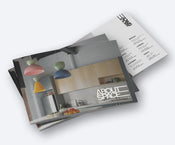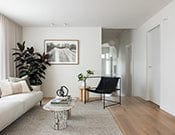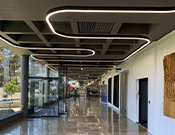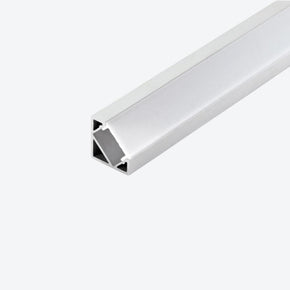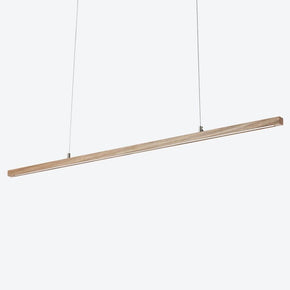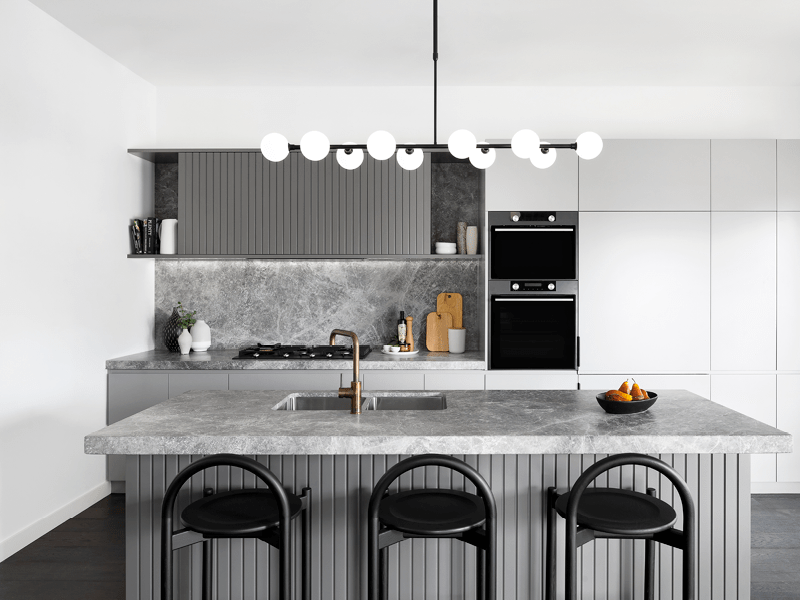- No products in the cart.
- ``
The Ultimate Guide to Lighting
21
Apr
Good lighting should never be an afterthought. Without it, spaces simply don’t work. Good lighting complements architectural features, enhances interior design and makes homes livable - any interior designer or architect worth their salt knows that lighting design is one of the most important aspects of the design process. But there’s more to lighting than meets the eye. To get your lighting plan right, you need a keen eye for design and a good understanding of the science and technology at its foundation.
So, whether you’re choosing a single piece for the home, or you need to light up an entire office, we’ve compiled this guide just for you.
What’s included:
- The 3 Lighting Layers
- Types of Lighting Fixtures
- How to Choose Lighting for Every Room in the House
- The Most Popular Lighting Styles
- The Different Types of Light Bulbs
- The Science & Technology Behind Your Lighting
- Installing & Styling Your Lights
The 3 Lighting Layers
Lighting designers use three ‘layers’ of light to enhance the look and feel of a space. Balancing these layers is as much a science as it is an art, but getting it right is essential to creating a space that feels comfortable and inviting.
Ambient lighting
Ambient or general lighting involves the illumination of a broad area. Ambient lighting does just as it implies - creates ambience. Ambient lighting is soft and sets the mood for your space. Ambient lighting is often achieved with ceiling lights, pendant lights or track lighting. In commercial spaces, recessed downlights are common.
Accent Lighting
Accent lighting is directional lighting that is used to emphasise a particular object or draw attention to a display item. Accent lighting is often a more intense light, enabling you to highlight architectural details, artworks, or special features. Types of accent lights include track lights, spot lights, picture lights and wall lights.
Task Lighting
Task lighting is the illumination of a specific area to enable you to carry out tasks in that space. Task lighting is often overlooked, but it’s one of the most important aspects of designing a functional home, office or commercial space.
It’s essential to think about how a space will be used and where specific task lighting will need to be placed. Certain spots in the home, like cooking and cleaning areas in the kitchen, work areas in the home office, above the mirror in the bathroom, or next to an armchair for reading all require task lighting. Task lighting can be achieved with strip lighting, pendant lights, floor lamps or table lamps.
Still not sure if task lighting is really that important? Check out more info on the power of task lighting.
Types of Lighting Fixtures
Not sure which fixture to choose? Read on for some of the most common types.
Ceiling Lights
Ceiling lights are, as the name would suggest, any lights that are mounted to the ceiling. There are a number of different ceiling light fixtures, from chandeliers and pendant lights, to track lights and downlights.
Pendant Lights

Everyone’s favourite lighting fixture, pendants typically hang from the ceiling by a cord, chain or rod. Pendant lights differ to chandeliers in that they only provide one source of light, although they can be clustered in groups.
Pendant lights come in a huge variety of shapes, sizes and designs so they’re extremely versatile. A singular statement pendant light is the perfect finishing touch, or they can be clustered together to make an even bigger impact.
Pendant lights can be hung at various heights, making them suitable for almost any room in the house, although they work especially well in the kitchen or dining area. Pendant lights are also popular in commercial spaces, from restaurants and cafes to retail spaces and hotels.
Great for: over a dining table or kitchen island
Recessed Lighting and Downlights
Downlights, also known as “recessed” or “can” lights, are mounted inside your ceiling. The light fixture sits behind a glass panel, which diffuses and throws the light downward in a narrow beam.
Because downlights sit flush with the ceiling, they look sleek and are a great choice if you have low ceilings.
Recessed lighting works best for ambient or task lighting because it may not diffuse light to the entire space. But you can light up a large space or an entire room by installing several recessed lights in a row.
While downlights can be installed in any room, they may be a bit too harsh for rooms where ambience is key, such as the living room or bedroom. While they do make for excellent task lighting, they should never be installed directly above a mirror because the angle will cast shadows.
Great for: in the kitchen and inside closets
Track Lighting and Spotlights
Track lighting consists of the “track”, which is the piece that’s mounted to the wall or ceiling and wired into your power source, and the “heads”, which hold the individual lamps.
Track lighting is popular in modern kitchens and bathrooms. Adjustable heads mean you can direct light in any direction.
Great for: accent or task lighting
Wall Lights and Sconces

Wall lights, also known as sconces, are, as the name would suggest, affixed to walls. Common in hallways, wall lights usually direct light upward and outward, rather than down. Wall-mounted lights are particularly popular when space is scarce, and are a great way to add task lighting, such as next to a bed for reading or along the length of a hallway.
Generally mounted at eye level, it’s a good idea to go for sconces that don’t have exposed bulbs, and opt for a nice warm light that won’t be too harsh on the eyes.
Great for: making a room feel larger and more inviting
Floor Lamps
Freestanding floor lamps provide an opportunity to really show off your style. Available in a huge range of styles, floor lamps are incredibly versatile and unlike other options, don’t require an electrician to install!
An essential element in your home decor, floor lamps are also functional, often positioned next to a reading chair, bed or couch as they provide perfect overhead lighting.
Floor lamps are a wonderful source of ambient lighting, and offer a flexible lighting solution, as they can easily move from room to room.
Great for: next to a reading nook or couch
Desk and Table Lamps

They might only be small, but a well-positioned table lamp packs a real lighting (and interior styling) punch. Adding a table lamp is a great way to instantly update your ambience and decor. Like floor lamps, table and desk lamps are portable, meaning they’re incredibly flexible and can be moved around and positioned to suit your room.
Desk and table lamps are essential in studies and beside beds, where you need direct task lighting. Your choice of shade is also an important consideration. Table lamps with light-coloured shades provide ambient and diffused light, while darker shades give off a moodier vibe.
Great for: the study
LED Strip Lights

LED strip lights consist of individual LED emitters mounted to a flexible reel that can be cut to size. Because they come with a peel-and-stick adhesive backing, they’re quick and easy to install and can be mounted in almost any location.
LED strip lights are often used in places where traditional light bulbs won’t fit, like under beds or behind shelves. These modest and flexible lights can be tucked away out of sight, while still emitting a warm and inviting glow.
Great for: under cabinets, above splashbacks, under vanities, around mirrors, and in wardrobes
Profile Lights

Profile lights are narrow linear lights that can be concealed, surface-mounted or suspended from the ceiling. Profile lights are highly customisable and can be cut to size and shape, and powder-coated in a variety of colours.
Their streamlined look makes them very popular in commercial spaces, from high-end boutiques to sleek offices, although they work equally well in homes. In retail environments, the soft lighting works exceptionally well to enhance the look of products on the shelves.
Great for: enhancing the look of shelves and products in retail spaces
Need a profile light in your life? Check out our 2By Collection.
How to Choose Lighting for Every Room in the House
When choosing lights for your home, it’s important to consider both function and form. That’s why layering your lighting is oh-so-important. A layered lighting plan for every room in the house will ensure your home is both functional and comfortable.
The Kitchen

Because the kitchen is often the central gathering point of the home, it needs lighting that’s not only practical but also looks great. To design functional and beautiful lighting in your kitchen, you’ll need a combination of ambient, task and accent lighting. Having an assortment of light sources means you’ll be able to adjust your lighting depending on what you’re doing in the kitchen, whether that’s cooking, cleaning or entertaining.
Task lighting is especially important to illuminate cooking areas. Opt for concealed strip lighting in cabinets and downlights in cupboards, as they’ll provide an even light that won’t cast shadows on task areas. Above a kitchen island, you could go with downlights or pendants. However, you may want to make sure your task lighting uses lower output bulbs or includes a dimmer to avoid harsh lights when you’re entertaining.
Ambient lights are all about setting a mood in the kitchen - think track lights and wall sconces to illuminate certain kitchen details and create a warm glow. Installing LED downlights under cabinets is also a great way to up the ambience. As long as they’re not too bright. And of course, many like to use pendant lights as an ambient light source. Just make sure to pick a pendant (or multiple pendants spaced evenly or clustered together) that emits enough light and spreads it widely across the area. Pendants work great over a kitchen island or dining table because you can generally hang them lower. Just don’t hang them too low if you still want people to be able to talk to each other across the table.
Tip: choose warm white bulbs for the kitchen. They’ll help to create a warm and inviting ambience
If you’ve got your heart set on a kitchen pendant, get more kitchen styling tips here.
The Dining Room

Layered lighting is particularly important in spaces that serve many functions, such as the dining room. You’ll want the flexibility to adjust the lighting in the room based on the task at hand, whether that’s soft lighting for entertaining, or bright lighting for reading the morning paper. Dimmers are essential.
Pendant lights are a popular choice over a dining table because they look great and they provide lovely ambient lighting for dinner parties. However, it’s important to get the size right. As a general rule, if the room is less than 3 metres wide, then a pendant less than 60cm will look best. Larger rooms can go for larger pendants.
It’s also important to consider the shape of your table. Rectangular tables look great with linear pendants or a row of pendants, whereas round tables look better with a singular central piece, like a single pendant or cluster of pendants.
Tip: when hanging pendants, don’t go so low that your guests won’t be able to see each other over the dining table. It’s generally recommended that your pendant sits about 76cm above the table.
The Bedroom
When lighting a bedroom, you need to take into account the impact that light sources can have on your sleeping patterns and general well-being. The brightness of your bedroom lighting and the colour temperature of the globes can have a real impact on the brain and your mood. Too-bright lights in the bedroom can trick your brain into thinking it’s daytime, meaning it’s harder to get to sleep and stay asleep.
For the bedroom, go for globes that measure about 1000 to 2000 lumens, to ensure they’re not too bright. Lamps next to the bed should be even less bright at about 300 to 700 lumens.
Colour temperature is also really important for the bedroom. You certainly don’t want to pick a cool white light as this will make the brain more alert. Instead, go for a soft warm white light that’s perfect for relaxing and getting you ready for sleep.
Task lights, like bedside lamps, and dimmers are great in the bedroom because you can use a softer, less-bright light when you’re in bed, or getting up in the middle of the night to go to the bathroom, without turning on bright overhead lights.
Need even more advice on setting the mood in the bedroom? Read our guide to better bedroom lighting or learn how to pick a bedside lamp.
The Bathroom

There are two main things you’ll need to consider when choosing a suitable fitting for your bathroom: position and safety.
In Australia, bathrooms have zones that tell us what lighting can be used within certain distances of water sources. There are four zones, with each zone requiring lighting with a specific IP (Ingress Protection) rating. The IP rating denotes how protected the electrical components are from dust and water.
| Zone | IP Rating |
| Zone 0 |
IP68Underwater-rated fittings only. |
| Zone 1 and 2 |
P44 OR IP65IP65 is a much stronger seal than IP44, but both comply. |
| Zone 3 |
Anything you want!But you should always consider steam in a bathroom and choose sealed fittings to avoid any problems. |
While you don’t need to light every corner of your bathroom to have a well-lit functional space, it’s important that you consider your general, task and ambient lighting.
For your general lighting, you can use a combination of task and ambient fixtures. Or it could be its own light source. Just consider putting brighter light fixtures on a dimmer so you can adjust the light level for early mornings or evenings.
Task lighting near the mirror is essential. The best placement is at eye level either side of the mirror for an even spread of light. Wall lights work great for this. Avoid placing lights behind you (such as downlights in the middle of the bathroom) as these will cast ugly shadows. For task lights, you want to pick a light that’s nice and bright.
For ambient lighting, one of the best ways to set the mood is to use LED strip lights under vanities and around mirrors. Tucked away out of sight, strip lighting produces a warm, indirect glow to set a relaxing mood in the bathroom.
Get even more tips on picking lighting for the bathroom
The Living Area

The living area is another space that needs to feel warm and inviting, while also being functional. When planning your living room lighting, take into account the activities you do in the living room, such as reading, and any special items, such as artwork and architectural features, that you want to highlight. Then it’s all about layering your lighting to ensure the room is properly illuminated for any situation.
Ambient lighting is usually achieved with ceiling lights. Choose dimmable so you can adjust the lighting - you’ll most likely want to dim the lights when you’re watching TV or relaxing. Downlights and pendant work great for ambient lighting because they diffuse light evenly throughout the space. Strip lighting is another excellent way to up the ambience. For example, strip lighting behind the TV gives off a real cinematic feel.
For task lighting, floor and table lamps work best. A table lamp next to a reading nook or a floor lamp next to the couch will provide all the light you need. Opt for adjustable heads for ultimate flexibility, and if floor space is limited, then an adjustable wall sconce works just as well.
Accent lighting is the final touch. Accents lights can be used to illuminate your favourite artwork or any interesting architectural details. Accent lighting also helps to make living spaces feel larger by illuminating any dark corners. Track lighting is great for accent lighting because you can adjust the heads in any direction you’d like.
Outdoors

When it comes to outdoor lighting, there are three factors you need to consider: safety, security and ambience.
Everyone loves entertaining outdoors, so thoughtfully positioned outdoor lighting is a must. Festoon and fairy lights are the perfect mood-setting addition for outdoor entertaining, while strip lights around water features and garden edges create a soft diffused glow. Uplights on trees and plants also make for a great feature.
To ensure your outdoor space is safe, install task lighting to illuminate decks, driveways, paths and barbecue areas and position spotlights above entrances. However, high illumination isn’t as necessary as it is indoors so it’s safe to go for a lower voltage light. And for security, motion-activated lights with built-in sensors are a great option to scare off any would-be intruders.
Get more outdoor lighting ideas here.
The Most Popular Lighting Styles
No matter your style, there's a light to suit any interior design.
Contemporary
Contemporary lighting embraces new and creative designs while remaining timeless in its simplicity. Featuring clean and bold lines, contemporary lighting is sleek but strong, with little over-the-top decorative detail or embellishments. Creating a design using a contemporary lighting scheme has become a lot more achievable in recent times with the creation of product family ranges. These family ranges will allow you to incorporate pendants, wall lights, floor lamps and table lamps into a single space resulting in perfect lighting consistency throughout.
Get the look with our Caterpillar Range here.
Australian Made

We might be biased, but Australian Made lighting is on our watch list. Our home-grown lighting designers and artists, some well-known and others emerging, are coming out with some exciting and inspired original designs. Not only do these designs look the part, but each and everyone of them come with a story that would have started on our own doorstep, and this is the real beauty behind something that is Australian Made.
In addition to this we know that when a product, and particularly a lighting product in this case, is produced on our own lands, the quality will be of the highest standards imaginable.
Get the look: Our Australian Made 2BY range provides the perfect example. These pendants are sourced, produced and manufactured in Victoria.
Minimalist
Less is more - that’s the philosophy behind minimalist design. Originating as an art movement in the 1960s, minimalism focuses on simplicity. Characteristics of minimalism include the use of raw materials such as glass, concrete and steel.
Everything in a minimalist interior is functional, sustainable and essential. Nothing is added for “effect”. Instead, the look focuses on the beauty of the form and the material used. Materials that work in a minimalist space include aluminium, steel, glass, ceramic, stone, textured wood, brushed bronze, and metals.
Get the look: Use strip lighting tucked out of sight for a minimalist look that’s still warm and inviting
Want more minimalist inspo? Check out our linear lighting range.
Mid-century modern
Mid-century modern design focuses on form and function. Taking inspiration from the era between 1945 and 1975, mid-century modern combines retro and contemporary. In mid-century modern design, you’ll see a lot of geometric shapes, bold colours, and mixed tones and materials. Wood, metal, chrome, glass and plastic feature heavily.
Get the look: go for bold silhouettes, sculptural features and futuristic space-inspired pieces
Coastal
There are many styles that fit under the umbrella of the “coastal” design trend, such as boho and Hamptons, but all give off that light, bright, beachy and carefree vibe.
More traditional coastal styles tend to feature neutral palettes and woven textures, such as rattan. Timber-framed lanterns and pendants with woven shades are a good option.
The Hamptons look often pairs cream with black or bronze accents, so black industrial-style metal and glass pendants work well against a neutral colour palette.
Get the look: take inspiration from the sea with nautical-inspired wall lights and pendant lights with woven shades
Industrial
Popular for its focus on functionality and simplicity, industrial style adopts elements like raw concrete, exposed brick and steel. Industrial pendant fixtures with ribbed glass shades, enamel shades, cool metallic colours, wire cages and exposed Edison bulbs feature heavily.
To offset the rawness of exposed materials, industrial design often softens harsh edges with warm ambient lighting or pops of bright colour. Warm LED filament bulbs work well in industrial spaces, as do federation greens, bright oranges and striking reds to contrast neutral walls and furniture.
Get the look: take your cues from the light fixtures that would have illuminated the factories of the industrial revolution
Commercial Lighting

Planning lighting for commercial spaces can be undoubtedly complex. Not only does commercial lighting need to complement the interior style of the space, but it also needs to be compliant with any industry or government regulations. Then there’s ensuring the lighting choices are fit for purpose.
When planning lighting for a commercial space, layering is critical to ensure a balance of task, ambient and general lighting. For a hotel, the most appropriate lighting for a lobby will be different from the lighting used in function areas. Restaurants will need bright task lighting in kitchens and bathrooms, but warm ambient lighting in the dining room. And retail stores will want bright ambient and accent lighting on the shop floor, and flattering task lighting in the changing rooms.
Lighting can have a huge impact on the people that use a space, so in addition to the lighting layers, you’ll also need to consider lighting temperature, CRI and a range of other technical aspects.
Getting the lighting temperature and CRI right is critical to ensuring your lighting is practical, functional and conducive to trading, whether that’s encouraging sales or ensuring a productive office.
For an office, cool, white light will make people feel alert and productive. However, it’s important to choose low-glare because too-bright lights can lead to eye-strain and headaches. For retail space, CRI is a critical aspect of your lighting design. A good CRI will enhance the appearance of products on the shelves and encourage sales.
The Different Types of Light Bulbs
It may not be the most exciting purchase, but getting your lightbulb right is just as important as choosing the right lighting fixture.
Incandescent
Characterised by a singular filament from 3 prongs, this globe has been phased out in favour of greener alternatives but can still be found in many homes. These bulbs have an energy rating of 0% as they use all the power they consume to emit light. They also have much shorter lifespans than other light bulbs (up to 1500 hours).
Halogen
Halogen lights are a type of incandescent lamp that uses a small globe within a larger glass bulb to produce light. Halogen bulbs use less electricity than incandescent bulbs and they have a brighter output and a longer lifespan (up to 3000 hours). However, halogen lights emit damaging UV rays and heat, so they’re mostly being phased out of use in Australia.
Compact Fluorescent Lighting (CFL)
CFLs are essentially the same as the fluorescent tubes you see in offices and gyms, just smaller. CFLs are very power efficient, with a lifespan of up to 10,000 hours. However, these globes are notorious for their “warm-up” period. These bulbs can take 3 to 5 minutes to get bright (and sometimes longer when it’s cold!). Fluorescent lights also emit high levels of UV which can distort colour.
Light Emitting Diode (LED)
LEDs are the most energy-efficient bulb on the market with a lifespan of about 25,000 hours. While they might cost a little more upfront, you won’t have to replace them nearly as often as other globes. They also give off much less heat and don’t emit harmful UV rays (they’re also less harsh on the eyes). LED lights are smaller than other options so can be used on strip lighting and in tight spaces like inside cabinets.
Ready to make the switch? Find out how to convert your old bulbs to LED with this guide.
Smart Globes
Smart globes are technically a type of LED, but given how popular they’re becoming, they certainly warrant their own section! Smart globes use wireless transmission to send and receive signals, meaning you can control the light remotely. Smart globes let you control the colour of the shade and can be paired with voice assistants like Alexa, Siri and Google Assistant, so you can schedule in or command your bulbs to dim or change colour throughout the day.
The Science & Technology Behind Your Lighting
Lighting isn’t just about pretty lampshades. Achieving exceptional lighting is just as much an art as it is a science! We list some of the most common scientific terms.
Colour Rendering Index (CRI)
CRI refers to the effect your lighting has on the accuracy and appearance of the colours in your surroundings. CRI is measured on a scale of 0 to 100, with 100 representing a 100% accurate colour rendering. For task lighting, it’s important to never use lighting with a CRI of under 60. As a general rule, a CRI in the 80s is best for completing most tasks. If colour is important, like in a retail environment or an art gallery, then the CRI should be above 90.
Read more on CRI and how it affects colours here.
Colour Temperature (Kelvin)
Colour temperature refers to the appearance of the light - how warm or cool it is. Colour temperature is measured in Kelvin (K) and ranges from very warm (1800K) to warm (2700-3300K) to daylight (3300-5300K) to cool (5300-6500K).
Kelvin can have a huge impact on the brain and mood. Cooler lights can stimulate the brain, making you more productive and alert, while warmer lighting is more ambient and is best used in homes and restaurants.
Want more info? Read our definitive guide to colour temperature.
Beam angles
The beam angle is the amount of light that spreads from a light source. It’s measured in degrees. For example, a living room ideally needs to be lit evenly, so a light with a 360-degree beam angle is great, whereas, in a dining room, you only need to light a table, so a 180-degree beam angle is just fine.
Wattage (W)
Wattage is the amount of power a globe will use when it’s turned on.
Lumen (LM)
Lumen is used to describe the amount of light produced by a lamp. The higher the Lumen, the brighter the output of the globe.
Luminous Efficacy
Luminous efficacy is the ratio of light emitted by a lamp to the power consumed by it. It’s expressed as lumens per watt. The higher the efficacy, the more efficient the light.
Confused? Get more info on how we balance luminous efficacy and power efficiency for better quality lighting.
Lux
Lux is a unit of measurement of the illuminance of light.
Diffusers
Diffusers are translucent screens used to shield a light source, softening the light output and distributing the light evenly.
IC Rating
The IC (insulation contact) rating is a measure used to determine whether a light can come into contact with insulation (such as a downlight installed in a ceiling).
IP Rating
The IP (ingress protection) rating is a measure of how protected the electrical components in the light are from moisture, dust and other particles.
Installing & Styling Your Lights
How to hang your lights at the right height
This is the most critical aspect of installing your lights, especially when it comes to pendant lights.
Large lights should be positioned higher in a space. If positioned too low, they may dominate the space or obstruct the view across the room. However, be careful not to place your lights too high either, especially if they’re on the small side. Lights hung too high can easily get lost in the space and may not emit enough light.
As a general rule, if you’re using your light as task lighting, they should be hung about 1.8 metres from the floor. Lights above dining tables can be hung a little lower at about 1.5 metres from the floor.
For pendant lights, you generally want to have more drop (cable) than shade height so that the balance of the fitting does not look top-heavy. For example, if the shade is 30cm, you want to have at least 30cm of cable.
How to choose the right size lighting fixture
Consider the size of your room before picking the size of your fixture. As a general rule, the bigger the space, the bigger your fixture can be. However, bigger is not always better - small lights are great for providing bright light while not dominating the space. Smaller lights are a good option for spaces that already have a visual feature that you don’t want to distract from.
While there are no set rules, there are some sources that suggest the size of a fitting should be no larger than the sum of the width and length of a space divided by 10 (e.g. 3 meters + 4 meters = 7 meters, 7 meters ÷ 10 = 70 centimetres).
How to choose the right light for your ceiling height
If your ceiling is above 2.4 metres, it’s safer to go with a large piece. If, on the other hand, you have a smaller space, large pieces can look cluttered. However, if you’re dealing with low ceilings, it doesn’t mean you have to forgo a pendant light altogether. It just means you need to be careful about where you put it. Over a dining table is your best bet - somewhere you can hang it quite low without it getting in the way.
How to light a small space
Small on space doesn’t need to mean small on style. When space is at a premium, lighting is your friend. Careful placement of lights can even make a space feel larger.
Wall lights are a great option because they don’t take up valuable floor space. LED strip lighting is also amazing for small spaces. It’s incredibly flexible and versatile, meaning it can be tucked away out of sight in almost any nook or cranny - think behind the TV or under cabinets. Track lighting is also great for small spaces because it takes up very little space but can be adjusted to direct light in any direction.
Need advice on lighting an apartment? Pick the perfect apartment pendant with our guide.
How to choose the right colour temperature for your space
In the past, most lighting designers would have recommended cooler lighting in task areas, such as bathrooms and kitchens, and warmer lighting in areas like the bedroom and living room. But with the transition to open plan living, it’s now recommended that colour temperature is kept the same throughout a space to ensure a consistent colour rendering.
Cool white lights (4000k) can feel somewhat clinical, so people tend to prefer warmer whites (3000k) for the home. There is, however, one interesting exception. For those living in a warmer climate, cooler lighting is often preferred to evoke a feeling of coolness after being out in the heat, while those in cooler climates tend to prefer warmer whites!
How to space your light fittings
There are really no rules about where to position your fittings. For downlights, generally it’s advised to place them approximately one metre from the wall and then spaced approximately two metres apart to allow an overlap of the beams.
For all other lights, it’s important to consider the furniture in the room, which areas need the most light and which features in the room you want to highlight. From there, you can decide where to put your fittings to ensure enough task lighting and accent lighting.
So...now you’re ready to talk lighting with the best of them. But if you need more help on designing your lighting plan or picking the perfect piece, book in for a lighting consultation.


